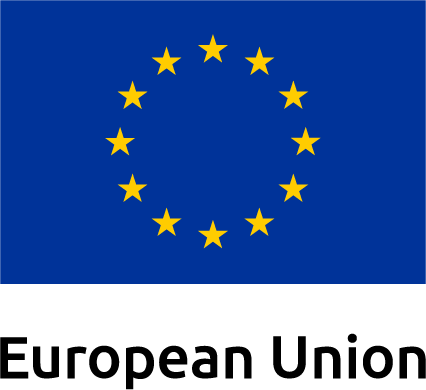• Biggest ever sales, settling at 1487 vehicles • Revenues at PLN 2.6 billion. Growth by 40% • European leader of electromobility. Over 500 commissioned electric buses for 2020
2019 was a record year for Solaris in many respects. First of all, the company has achieved its biggest ever sales volume. All in all, the manufacturer has supplied 1487 vehicles. Furthermore, Solaris saw record sales revenues of PLN 2.6 billion in 2019. This represents a climb by nearly 40% year-on-year. For 2020, the firm is setting itself ambitious sales targets. And it is already clear that this year, the firm will deliver over 500 electric buses.
Chart: Solaris revenue over the years 2016-2019 in millions of PLN
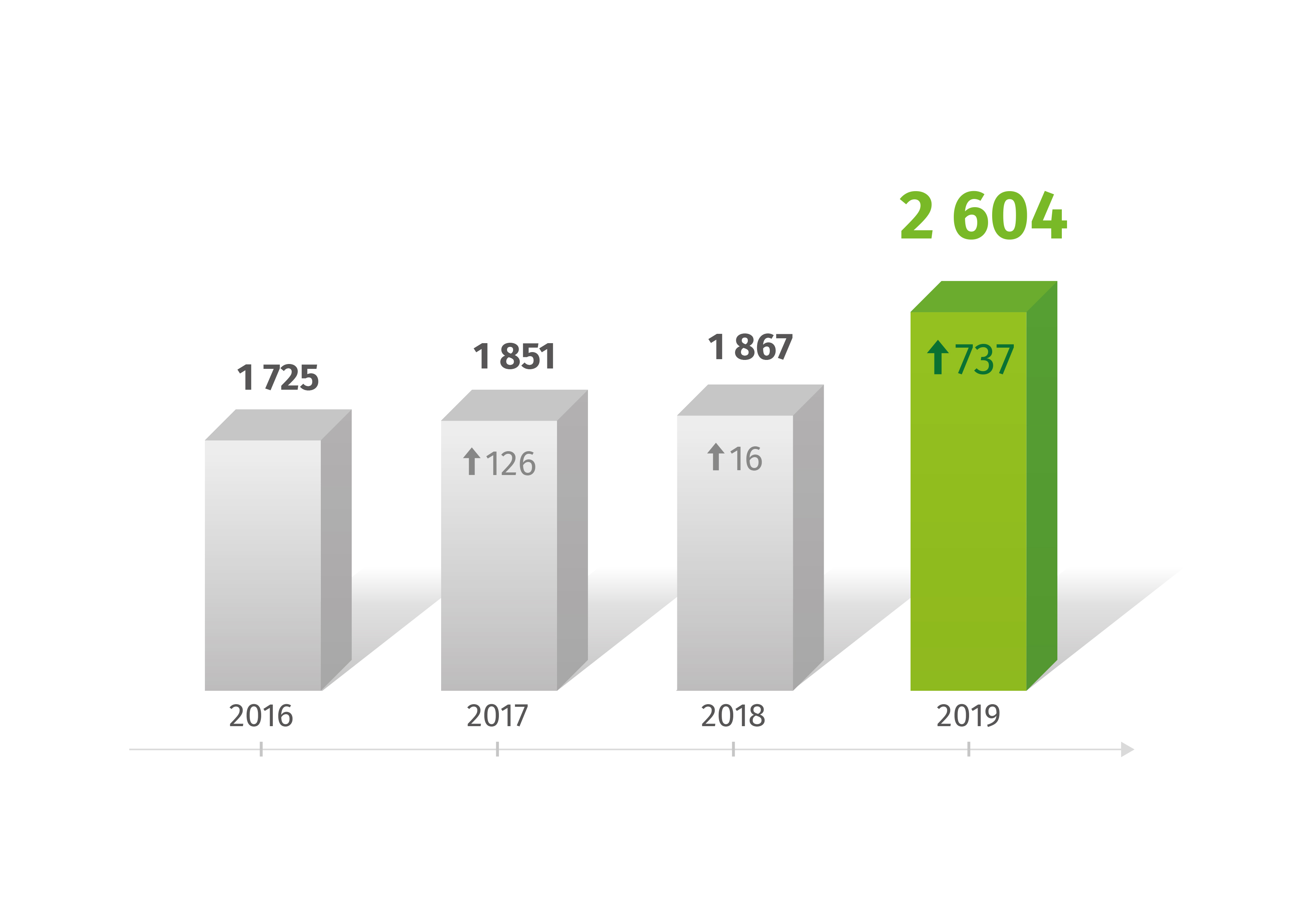
Source: Solaris Bus & Coach S.A.
In 2019, Solaris sold a record number of 1487 vehicles. That is the best result ever achieved by the company. The previous record sales volume occurred in 2017 and was by nearly 100 buses lower (1397).
Chart: Sales of Solaris vehicles from 2016 to 2019 in units
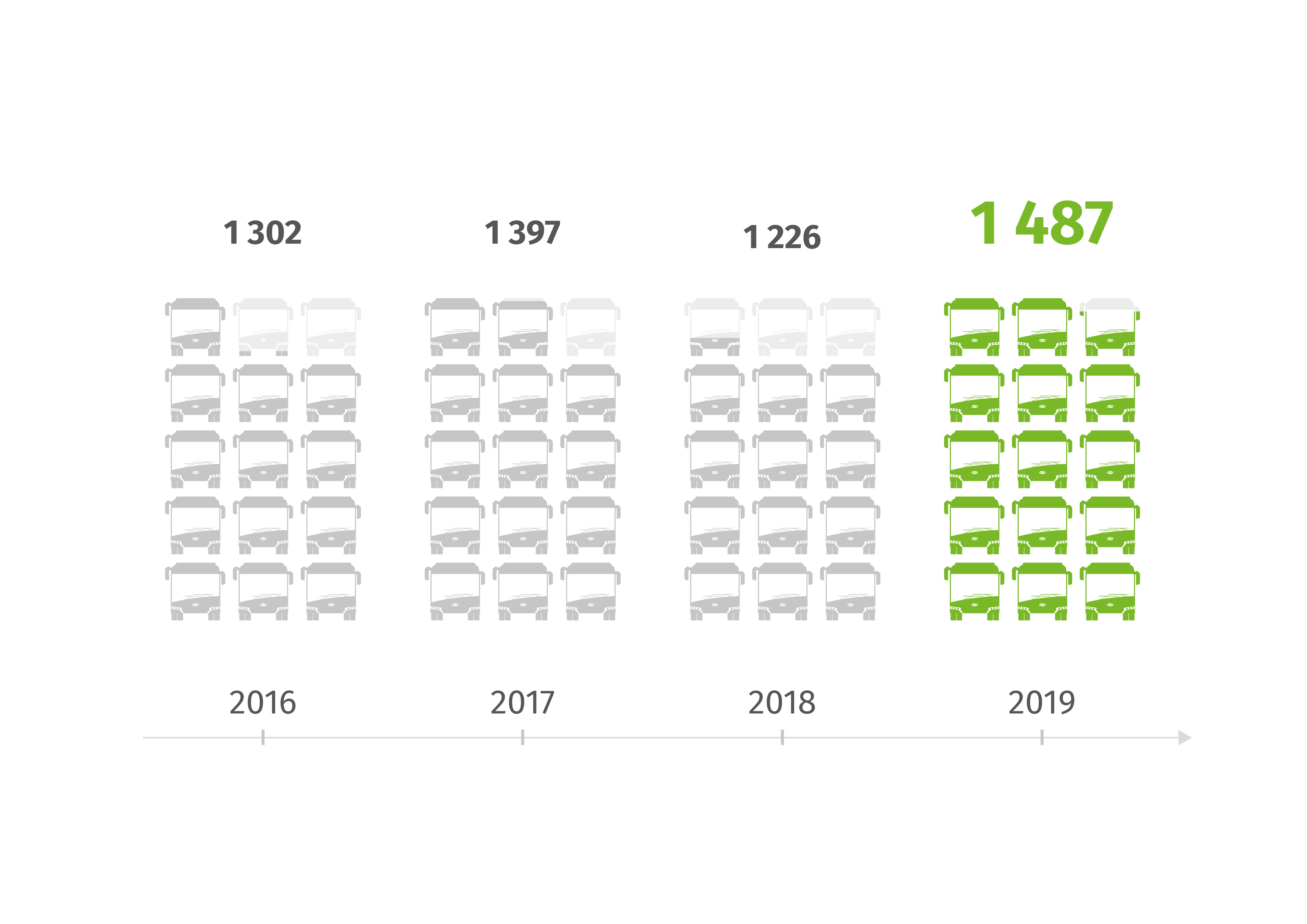
Source: Solaris Bus & Coach S.A.
Currently, products of Solaris can be found in 32 countries, in over 750 cities. In total, the manufacturer has supplied nearly 19,000 vehicles to its customer so far. In 2019, the biggest sales markets of Solaris were Poland, Germany, Belgium, Lithuania and Italy.
It should be stressed that Solaris is very dynamically developing its sales position on European markets but it is also quickly refocusing the organisation of production and after-sales servicing towards vehicles with alternative, low or zero-emission propulsions. In 2018, hybrid and electric buses as well as trolleybuses constituted in total 29% of all vehicles sold. Meanwhile, in 2019, their share in sales increased by 11 percentage points to 40%.
Chart: Share of alternative drives vs. conventional ones in structure of sales of Solaris in 2018 and 2019
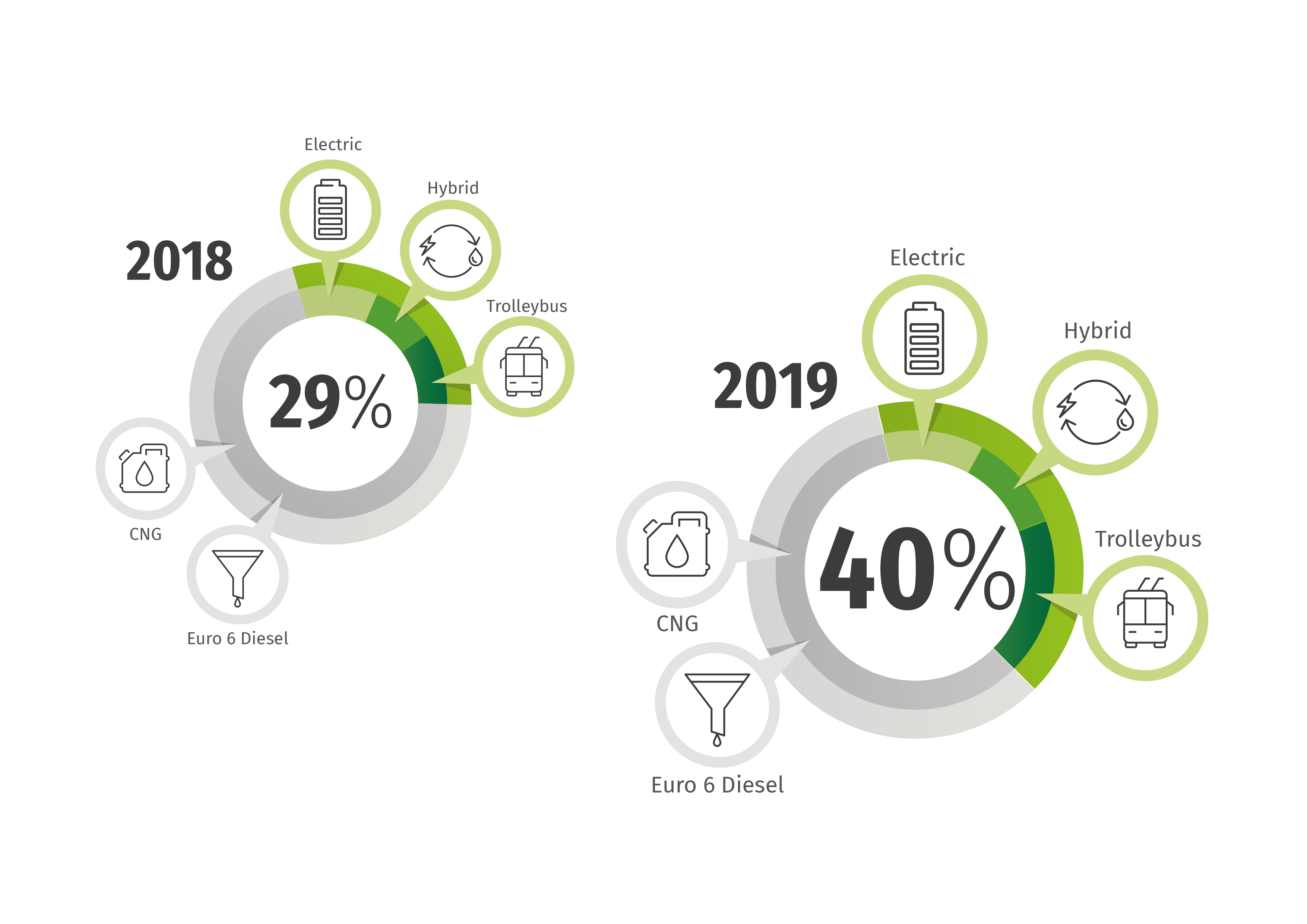
Source: Solaris Bus & Coach S.A.
Solaris is an indisputable one of the European leaders of e-mobility. The number of sold and contracted electric buses made by Solaris has been growing dynamically for a few years now. In 2019, the manufacturer has supplied in total 162 battery buses, which marks a rise by 51% versus 2018.
Based on the orders already secured, it is possible to assume sales of battery buses of Solaris at a level of at least 500 units in 2020. The contracts due to be performed this year include among others the mega order for 130 articulated Solaris Urbino 18 for operator MZA in Warsaw, or the framework agreement for the supply of 250 Solaris Urbino 12 electric buses for Milanese operator ATM. Compared to 2017, this represents an over eightfold increase of orders secured for electric buses!
Chart: Number of electric buses made by Solaris sold until 2019 and orders for battery buses for 2020
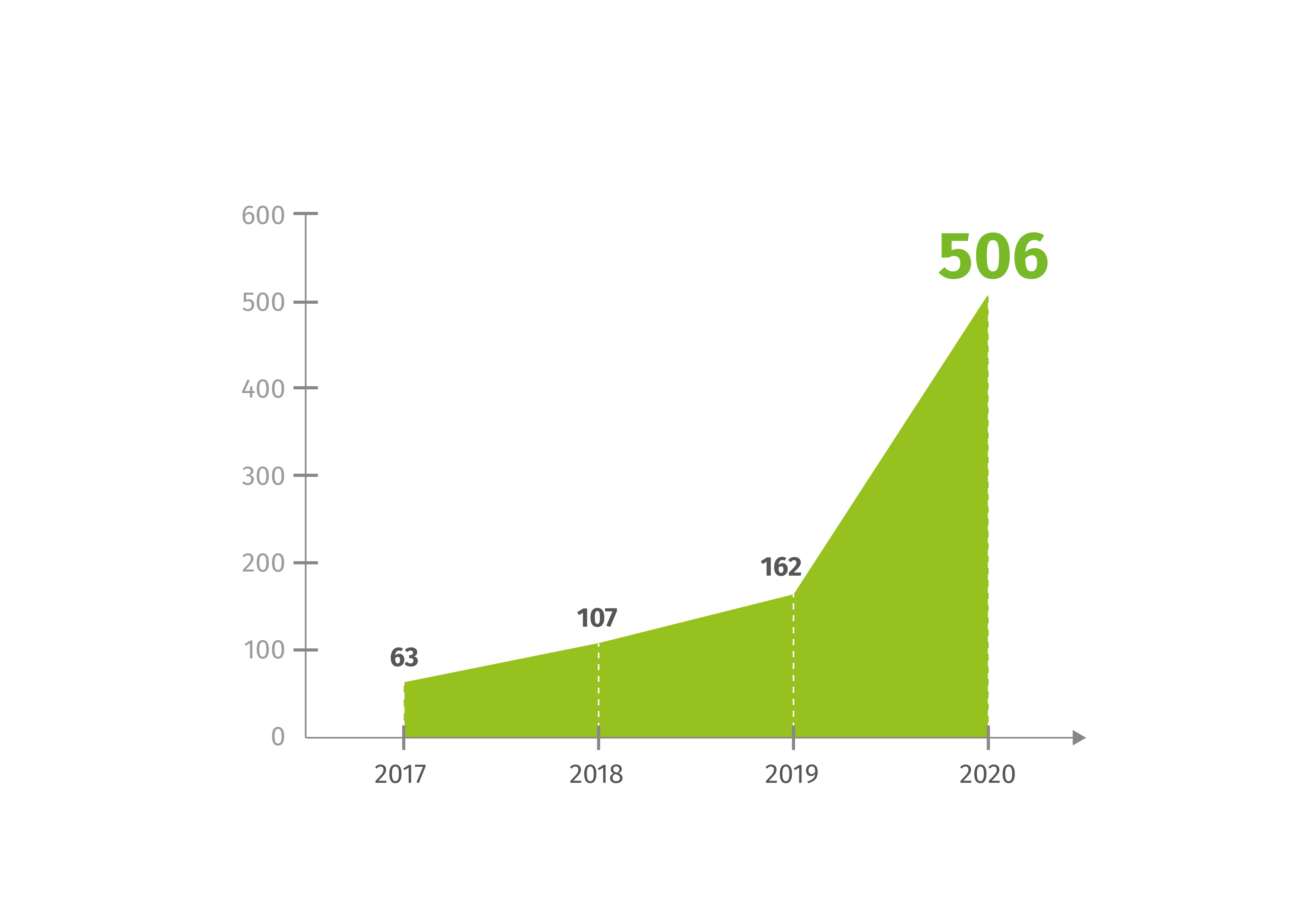
Source: Solaris Bus & Coach S.A.
The rising significance of electric buses in the sales structure of Solaris is consistent with the long-term development strategy of the firm, as well as of the whole CAF Group which Solaris is part since 2018.
The trend of a growing share of low or zero-emission drive vehicles in the company’s sales and production structure will certainly continue in 2020. It is also consistent with the trends of the whole EU and EFTA market which is the chief area of commercial activity for Solaris. For a few years now, these states have seen an unusually dynamic climb of demand for low and zero-emission vehicles in public transport.
This is also evident in the number of battery buses ordered in EU and EFTA states in 2018 and 2019. When comparing the number of battery buses commissioned year-on-year (2018 – 1313 units / 2019 – 2341 units) we see that this segment has recorded a 78% surge. Solaris is one of the leaders of this transition of the market towards e-mobility. Company was of the first movers and promotors of e-bus technology and continues its leading role for many years now.
In order to respond to the growing needs of the market for low and zero-emission vehicles, Solaris is continuously developing its portfolio of products in this respect.
In 2019, at the Global Public Transport Summit in Stockholm, the Polish company presented the new generation of its hydrogen bus Solaris Urbino 12 hydrogen. The main source of energy for the vehicle is hydrogen which is transformed into electricity which, in turn, feeds the propulsion system.
Hydrogen technology used for power generation will enable buses to traverse even longer distances completely emission-free. Hydrogen-fuelled buses will allow to create a complementary emission-free bus portfolio thanks to which Solaris will be braced for contemporary challenges and the diverse needs of customers with regard to range, flexibility and operability of vehicles. The manufacturer believes that the development of all electromobility branches, be that battery buses, trolleybuses or hydrogen-fuelled vehicles, should proceed in synergy, and that this process is indispensable to ensure sustainable transport of the future. Therefore, hydrogen-powered buses of Solaris will not constitute competition for battery buses or models of the Trollino series. Quite the opposite: these technologies will complement each other perfectly and they will all benefit from the technological progress of electric drivelines and their components. It is worth noting that in 2019, Solaris secured its first orders for hydrogen vehicles. Transport firm SASA Bolzano has ordered 12 units of the Urbino 12 hydrogen model, to be delivered in 2021. Thus, Solaris is proving that since 2014 it is a reliable partner in hydrogen technology, having its hydrogen vehicles already delivered to Hamburg and Riga.
Another product novelty presented by Solaris in 2019 was the bi-articulated Trollino 24, which is the longest vehicle assembled by manufacturer so far. The idea behind the Trollino was to create a platform for the future serial production of 24-metre vehicles with an electric or hybrid driveline and of trolleybuses.
Back in 2011, when Solaris unveiled its first electric bus, its offer included only one battery option. Over the next years the company has remarkably extended its technical competence in this area. Over 25 million kilometres covered by the Urbino electric buses and experience gathered from the operation of vehicles in dozens of cities in various climates make it possible for Solaris today to offer the optimal battery solutions to its customers. The firm’s latest development are the Solaris High Energy+ batteries. These were designed by the Solaris Research and Development Department, bearing in mind the needs of carriers who want to cover at least 200 km on a single charge, regardless of the weather conditions, and thus regardless of air-conditioning or heating working. The Solaris High Energy+ batteries are characterised by an extremely high energy density. Thanks to this feature, battery offers 79 kWh into one pack. This means that in the case of 7 packs – that is how many can be installed in an articulated bus at the most – it can be reached a nominal energy rate of 553 kWh. It may be worth underscoring that the solution is the result of cooperation between the Solaris and BZM Poland Research and Development Departments. Batteries of this type can be used only in Solaris vehicles and as of today, no other producer in the electric bus market is offering them.
Embracing the global development of the e-mobility market and the customer needs which Solaris continuously monitor, company has ventured to design a very special product. The eSConnect is
a modern system of monitoring and fleet management dedicated to those Solaris clients who have decided to purchase emission-free vehicles. eSConnect software represents a multifaceted tool that enables the efficient management of a fleet of electric buses and the optimal use thereof. The eSConnect is an accurate diagnostics instrument, facilitating and supporting maintenance capacities. The methodically constructed base of physical performance data allows for the conscious and economical use of the bus fleet by drivers and its management by operators. The collected data allow customers to accurately define the technical requirements for buses used on particular routes and lines. One tangible benefit of the data base in development is the possibility of perfecting applied solutions by the producer itself. It is worth noting that the eSConnect system may be installed both in every newly produced electric bus, as well as in those already delivered to customers.
Standing out among the many functionalities offered by the eSConnect system to users are:
- access to vehicle data in real time;
- monitoring of up-to-date operating parameters of the vehicle, such as energy consumption, battery charging status, predicted range;
- real-time bus fleet location tracking;
- monitoring of routes of particular vehicles;
- generating statistics and reports on, i.a., the number of charging cycles and the time needed to recharge batteries;
- real-time identification of defects or alerts signalled by the vehicle on the driver's panel;
- identification and analysis of possible anomalies with notification of the operator;
- swift maintenance support - the Solaris service has remote access to diagnostic data which substantially shortens the repair time.
The data collected by the app are presented in a visually appealing form of charts and graphs. As the functionalities of the app get expanded, the current users will be guaranteed regular updates. It is worth noting that the eSConnect was fitted with an API interface that allows for its integration with external programmes.
Another R&D projects developed by Solaris in 2019 are the new ADAS Solutions (Advanced Driver Assistance Systems) available in Solaris vehicles. Active driver assistance systems help drivers by performing certain actions before them or in their stead, and thus provide them with invaluable seconds for a proper response. One of systems is Collision Mitigation System (CMS) which initiates automatic braking. When a radar installed on top of the bus detects the risk of a potential head-on collision, the system goes into braking mode, reducing velocity and thus alleviating the consequences of a potential collision. Moreover, Solaris has presented new solution reducing “blind spot” effect for drivers. Cameras placed outside the vehicle detect pedestrians and cyclists who are not reflected in mirrors, especially during turns, even if it may seem to them that they must be visible to the driver. In order to solve this challenge, Solaris has availed itself of the Mobileye Shield+, a system warning the driver – with acoustic signals and visual alerts on the display – also in cases when changing lanes without adequate signalling beforehand or when no appropriate distance to the vehicle in front is maintained. The system also alerts the driver to collision risks. The device detects every pedestrian and cyclist within 80 cm from the bus, alerting the driver to their presence – again, acoustically and visually on a display. What the driver does not see in the mirror is pointed out to them by the camera steering device.
An enhanced visibility is also ensured by the completely re-designed mirrors, or rather cameras which project the image onto screens inside the vehicle. The ingenious design of the MirrorEye installed in lieu of regular rear-view mirrors corresponds to class 2 and 4 visibility (optionally class 5 in the right “mirror”) and this yields a whole range of advantages. What is more, the cameras substantially widen the field of view and they improve the aerodynamics of the vehicle.
Meanwhile, in 2020, Solaris is going to present its latest offer in the electric bus segment. This will be the low-entry Solaris Urbino 15 LE electric. The tri-axle bus is built mainly with customers of the Scandinavian market in mind. The vehicle will be available both as a typical city bus (class I) and also as an intercity bus (class II). The low-entry bus is designed mainly with operators from Scandinavian markets in mind, which is where the demand for this type of vehicle, serving in urban traffic but also for intercity transport, is huge. The Solaris Urbino 15 LE will be offered either with two or with three doors (2-2-0 or 2-2-1 layout), and it will be able to carry up to seated 55 passengers. Energy will be stored in Solaris High Energy+ batteries of the latest generation, boasting extremely high energy density and a capacity that will ensure an adequate travel distance both on city and on intercity routes. Two battery charging modes will be possible, depending on the users’ preferences, involving either a plug-in charger or a bus roof-mounted pantograph. Over the next weeks, the company will finish the design stage regarding the new vehicle and it will launch production of two pre-series buses. One ought to highlight at this point, that even now operators from one Scandinavian country have confirmed their interest in testing the vehicles in real road conditions.
“2019 was a record year for Solaris in many respects. What we have achieved thanks to our employees and thanks to the trust our customers put in us is fantastic. This year, we will face new challenges, related above all to the continuous dynamic development of electromobility. We plan further increases of sales and output. In 2020, we assume the supply of over 500 electric buses. Of course, this entails further investments and the optimisation of servicing processes and structures, in order to ensure the highest possible service quality for all our clients from the moment of vehicle delivery, throughout the whole service live of the vehicle,” said Javier Calleja, CEO of Solaris Bus & Coach S.A.
Information Solaris
Additional information
Mateusz Figaszewski
Institutional Partnerships and External Relations Director
mateusz.figaszewski@solarisbus.com
